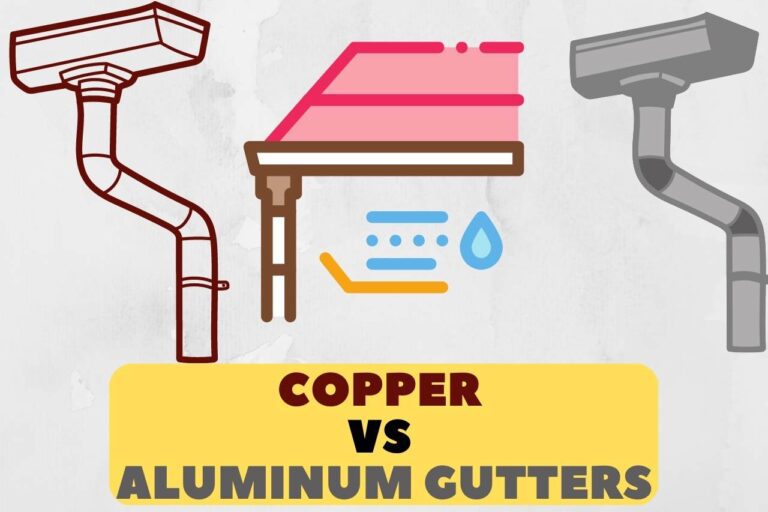How to Fix Gutters that Overflow? (Gutter Repair Tips)
A gutter is like a pipe that carries rainwater from the roof’s edge to the ground. Some gutters look like indentations at the curbs, with water flowing into trains from them. A trough protects the housing structure from damages caused by the water flowing on top of the roof. A gutter is simple yet essential as part of a roofing system. It protects the property by controlling soil erosion and preventing any leaks from the rain. Gutters come in many shapes and forms, and types of materials. It can be plastic, steel, PVC, metal, or concrete. A Gutter can have many issues over time or when not constructed properly; let’s see how to fix gutters that overflow.
Why is Water Pouring Over My Gutters?
There are very common reasons why water may pour over the gutter. One reason can be the clogs in the drain. Usually, when the trough is not cleaned or maintained, debris, rotten leaves, moss, or squirrel nests can be stuck in the gutter way. When there is rain, the water gets blocked at these clogged paths, overflowing from the roof onto the ground.
Another reason includes heavy rain and storm. When heavy rain is pouring, the gutters fill with more water than they can hold. Or sometimes your channel might get damaged due to heavy rain. During this time, the drain tends to overflow.
Some people build very narrow gutter pathways. So, during harsh and heavy pours, the gutter tends to overflow. Narrow gutters clog quickly as well, making it even more obvious. And it’s important to ensure you build a proper gutter system with an accurate pitch for a smooth water flow into the downspout. Such gutters without a good tilt can collapse easily and fast.
How to Fix Gutters that Overflow?
There are a few ways to fix the gutter, depending on the issue it is centered around. For example, if the problem is a simple clog in the channel, place a ladder around where the clog is present. And remove the dirt, debris and leaves collected clogging the drain. Try using a flashlight and observe the downspout for more debris and dirt. Clean the gutter well and pour water over it to check for clear sight.
The tilt or pitch that angles the water flow should be slanted if the pitch is damaged or not perfectly levelled. Check the gutter with a level, and if you find any problem, try and fix it. For every 10 feet, the tilt should be ¼ and 1/8″. Make sure the gutter tilt is not too high or too flat.
Suppose the gutter is overflowing because it needs to be wider or because it is too old and ageing. Make sure to replace them with wider gutters. This will help with a smooth flow of water and reduce the collection of debris.
Another way to maintain the safety of your gutter is to clear them occasionally and use gutter protection guards and ice build-ups because ice dams can sag the gutter and make it collapse. One can also use a gutter helmet and a cap with heaters to prevent ice dams from forming in winter.
What is a Gutter Overflow Protector?
A gutter overflow protector is used to guard the gutter against all forms of external damage and impact. The protector or gutter guard protects against leaves, pine cones and other moss and debris from getting collected in the gutter, preventing water flow. Installing a cover to your gutter helps prevent ice dams that are damaging. There are several types of protectors available to choose from; it can be a bottle brush, foam filler, nylon, mesh or a reverse cover guard that sits perfectly on top of the gutter.
Why are My Gutters Overflowing but Not Clogged?
The most commonly known reason for gutter overflow is a clog. But in addition to clogs, the reason for the surge includes too much rainfall filling over the gutters. Sometimes the weather is too unpredictable and harsh; it can be a heavy rain or storm.
Sometimes the winds that blow can unhinge the channel from your roof, letting the rain pour over them and damaging the property. And, sometimes people need to build more gutters for a complete water drain, and very few downspouts and gutter pipes can let the water overflow.
Next would be narrow gutters, which are not good enough to handle a harsh downpour. Or the drain could be old and damaged. For this, you can replace the gutter with a wider one. If the gutter is a metal or steel gutter, it can rust over time with use and corrosion. When this happens, the trough will start pouring water through the rust holes, messing up the water flow.
How to Keep Gutters from Clogging?
One way to prevent the clogs is to have a clean gutter free from debris, leaves and dirt blocking the downspout. When the gutter clogs, the water starts overflowing, draining over the walls, cracks and other foundation areas into the attic and basement. Keep a set date specifically to clean the gutter so you remember to clean.
Check around the roof and other parts of the house close to the gutter for larger debris like broken or chipped wood and roofing materials. And remove them to prevent clogs. Another common solution is to install a protector or guard for the gutter. This will prevent any debris, leaves or dirt from getting collected.
Several gutter systems are premium-grade gutters. One can install copper, zinc, steel or aluminum gutters that are strong and sealed from external damage with the ability to filter debris easily into the downspout. Some people even use leaf blowers to get the leaves out of the gutter, especially during autumn when many leaves get collected, clogging the drain.
One should also make sure to get all the branches and trees cut and trimmed that may blow dry leaves into the gutter. You can use a gutter cleaning kit, dust mask and gloves to protect yourself from danger. Another simple way to clean clogs is to use a gutter scoop or clean it by hand.
You May Also Like


